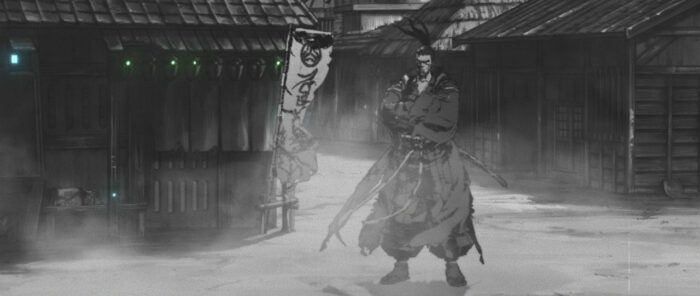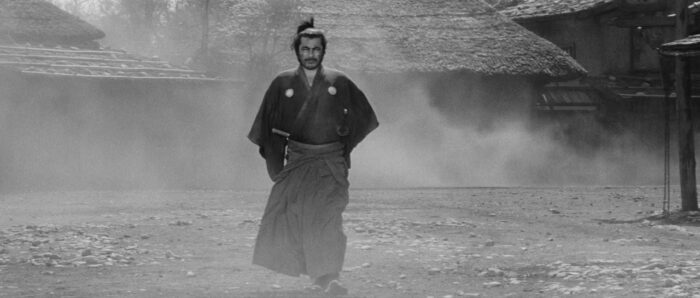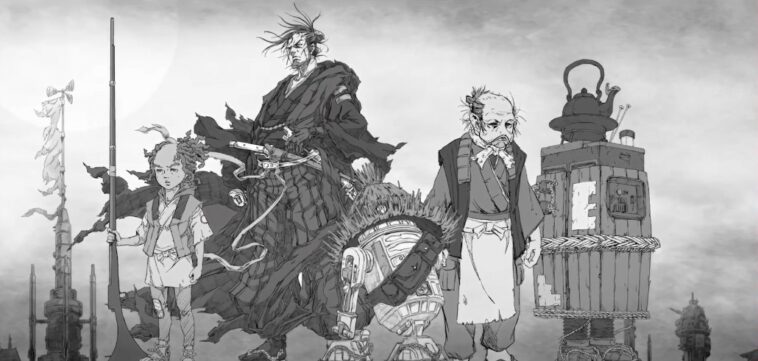When A New Hope released in 1977, its explosive success shocked studios and even Lucas himself. Its sparse 43 theatre release would reverberate through and redefine both the science fiction genre and the nature of blockbusters as a whole. The film blended familiar American staples like sci-fi serials and spaghetti westerns with pivotal Japanese cinema. With its record-shattering debut, Star Wars played a significant role in bridging the chasm between mass-market entertainment and arthouse cinema.
Though set in a universe that harkened back to pulpy space epics such as Flash Gordon, Star Wars‘ cinematic scaffolding appropriated many elements from the seismic works of Akira Kurosawa. Hailed as one of the most significant directors of all time, Kurosawa’s tales of feudal Japan provided the narrative and visual foundation that A New Hope is built upon.
Now, with the release of the anime Star Wars: Visions, the franchise is actively embracing this legacy. Produced by seven renowned Japanese studios, the series is a diverse set of artfully animated shorts—each offering only a brief glimpse into the untold stories of the Star Wars universe. While episodes differ drastically in design and story, several pay tribute to the revered films woven into the fabric of the franchise. Their bold, lightsaber-brandishing protagonists walk in the footsteps of Kurosawa’s iconic heroes. Exchanging the arid dunes of Tatooine for misty mountainside villages, these episodes honor the tales that originally ignited this universe.
While Kurosawa’s presence can be detected throughout the Star Wars canon, his most salient influence is the 1958 film The Hidden Fortress. The movie tells the story of a grizzled samurai general as he escorts an exiled young princess to safety. A basic premise that no doubt sounds more than a little familiar. Though A New Hope diverges sharply from its predecessor with the fabrication of Luke Skywalker, who possesses no corresponding figure, many other key characters emulate the archetypes from Kurosawa’s film.

The film’s preliminary characters, R2-D2 and C-3PO, are one of the strongest examples of this, imitating the quarrelsome peasants Tahei and Matasachi. Both pairs act as the film’s deuteragonists—secondary companions through which the story is being told. Kurosawa deliberately elected to present his story through the eyes of the lower-classes. An innovative choice that resonated deeply with Lucas, it was one of several he chose to replicate in A New Hope.
When Alec Guinness took up Obi-Wan Kenobi’s lightsaber in 1977, his composed and meditative performance would serve as the bedrock that Jedi lore would build upon—a character and performance informed not simply by the samurai of ancient Japan, but by Kurosawa’s specific depiction of them. Played by the iconic Toshiro Mifune, Makabe Rokurōta is the noble protagonist of The Hidden Fortress and the mold for Kenobi’s character. Still loyal to the shattered Akizuki clan, Makabe is, like Obi Wan, a vestige of a bygone era. Regardless, he remains stalwart and unwavering in his dedication to the code and order he has sworn to uphold. His skill matched only by his wisdom and devotion, Makabe is still a dangerous and capable warrior. Kurosawa’s hero was not only the foundation for Obi-Wan, but by extension the progenitor of the entire Jedi order.

The honor, benevolence, and stoicism that Makabe and Kenobi both embody formed the core of the Jedi dogma. And while the expansive Star Wars universe extends far beyond the Jedi order, they indisputably remain at its heart. Through them, Kurosawa’s influence permeates the DNA of the entire franchise.
Visually, Lucas also borrowed a great deal from Kurosawa’s cinematography. Most unmistakably in his use of swipe transitions. Now a Star Wars hallmark, they were originally taken from The Hidden Fortress, among other Kurosawa films. A New Hope also features prevalent use of wide-framed shots that are often attributed to the film’s of Kurosawa’s films.
While Japanese cinema helped constitute its framework, Star Wars has certainly gone on to curate its own influence and identity. In the 44 years since its conception, the franchise has distanced itself from its samurai origins. That was, until Disney released Visions on September 22nd. Produced exclusively in Japan, Visions represents an interesting inversion of the cultural exchange that spawned A New Hope. Reinterpreting and reexamining iconic components of Japanese cinema that have been transformed by decades spent steeping in western culture. The studios behind the project are legendary. Responsible for some of the most popular anime of modern times like JoJo’s Bizarre Adventure, Kill la Kill, and Ghost in the Shell.
The series is a 9-part anthology, so each episode is an original, self-contained story. And although each short is unique, several select a setting that clearly mirrors Kurosawa’s Japan as their backdrop. The shorts are officially non-canon, giving creators license to strip away some of the aesthetic baggage the universe has accumulated over the decades and expose the historical roots underneath. The ethereal whistle of Japanese Shakuhachi flutes take the place of Williams’ signature blaring trumpets. Tattered nobori banners flutter in the breeze. Surrogates for the buzzing, neon signage that typically pervades the scenery. Lightsaber duels eschew high-flying acrobatics in favor of a more restrained, staccato fighting style.
While several episodes of Visions reincorporate elements of Japanese cinema into the Star Wars universe, none are a more explicit homage than the show’s opener. The Duel (created by Kamikaze Douga) is the series’ overt love letter to Kurosawa. The short flickers across the screen in a grainy black-and-white, immediately establishing itself as a direct descendent of the franchise’s ancestor. Like A New Hope, the episode is a fairly flagrant adaptation of another of Kurosawa’s films, Yojimbo. ‘Bodyguard’ in English, the film tells the story of the mysterious ronin Sanjuro, a master-less samurai, who hijacks a village’s ongoing turf war for his own benefit. The movie is the direct inspiration for Sergio Leone’s A Fistful of Dollars, another film with a significant influence in A New Hope.
The Duel explicitly incorporates many of the same components from Yojimbo that Lucas and Leone did. The short also follows a reticent ronin drifter who inserts himself into a town’s conflict with a band of criminals. Like Yojimbo, The Duel takes place on the periphery of a decaying empire. The former in a small village during the final years of Japan’s golden Edo period. The latter on an Outer Rim planet that sits beyond the faltering reach of The Empire. Lawless frontiers, both are an ideal setting for the kind of laconic anti-hero these stories center on.


In both stories, the protagonist is an enigma. Whatever past they posses remains shrouded in the mist-laden pine tree forests they amble out of. Who they are is unimportant, what matters is what they are capable of. Ultimately motivated by self-interest, these lethal drifters are content to provide aid to the villagers so long as it aligns with their goal. In Yojimbo, Sanjuro successfully rids the town of its belligerent and destructive gangs, but not before lining his own pockets. When The Duel‘s nameless ronin bravely confronts the powerful sith extorting the town, it initially seems altruistic. However, the glistening collection of ruby-red Kyber crystals that line his threadbare cloak reveal him to be a hunter with a quarry, not a protector of the innocent.
The Duel begins as it ends, with a shot that is nearly identical to Yojimbo‘s. Both stories conclude with their reluctant hero exiting as unceremoniously as he entered. Each tale only a small portion of what feels like a much larger narrative tapestry.
While George Lucas has never denied that his films adopted several of its key facets and characters from Kurosawa, never before has the franchise so openly acknowledged its heritage. Star Wars: Visions is both a love letter to, and reinterpretation of the Japanese films that inspired its universe. The show effortlessly balances the franchise’s two major cultural influences, blending Kurosawa’s revolutionary composition and Lucas’ imaginative universe.
Looking forward, fans are hopeful that the upcoming Kenobi limited series will embrace this return to form. Disney has also announced the release of a Ronin novel. Releasing on October 12, the book will pick up immediately after the events of The Duel.
In the meantime, however, all nine episodes of Visions are available now on Disney+. Additionally The Hidden Fortress and Yojimbo are currently streaming on HBO Max. With the Star Wars universe re-centering Kurosawa, there has never been a better time to explore the director’s foundational films.

